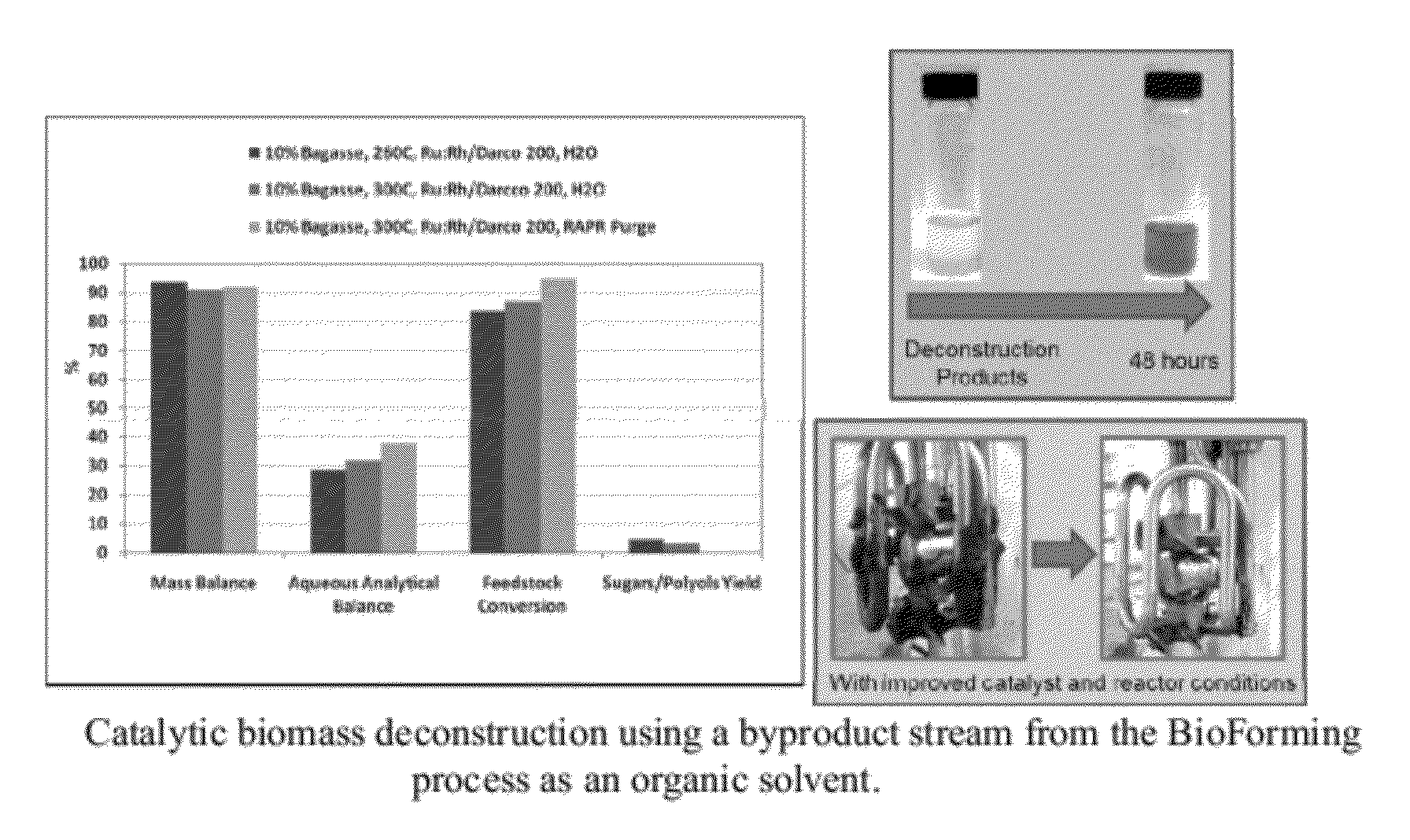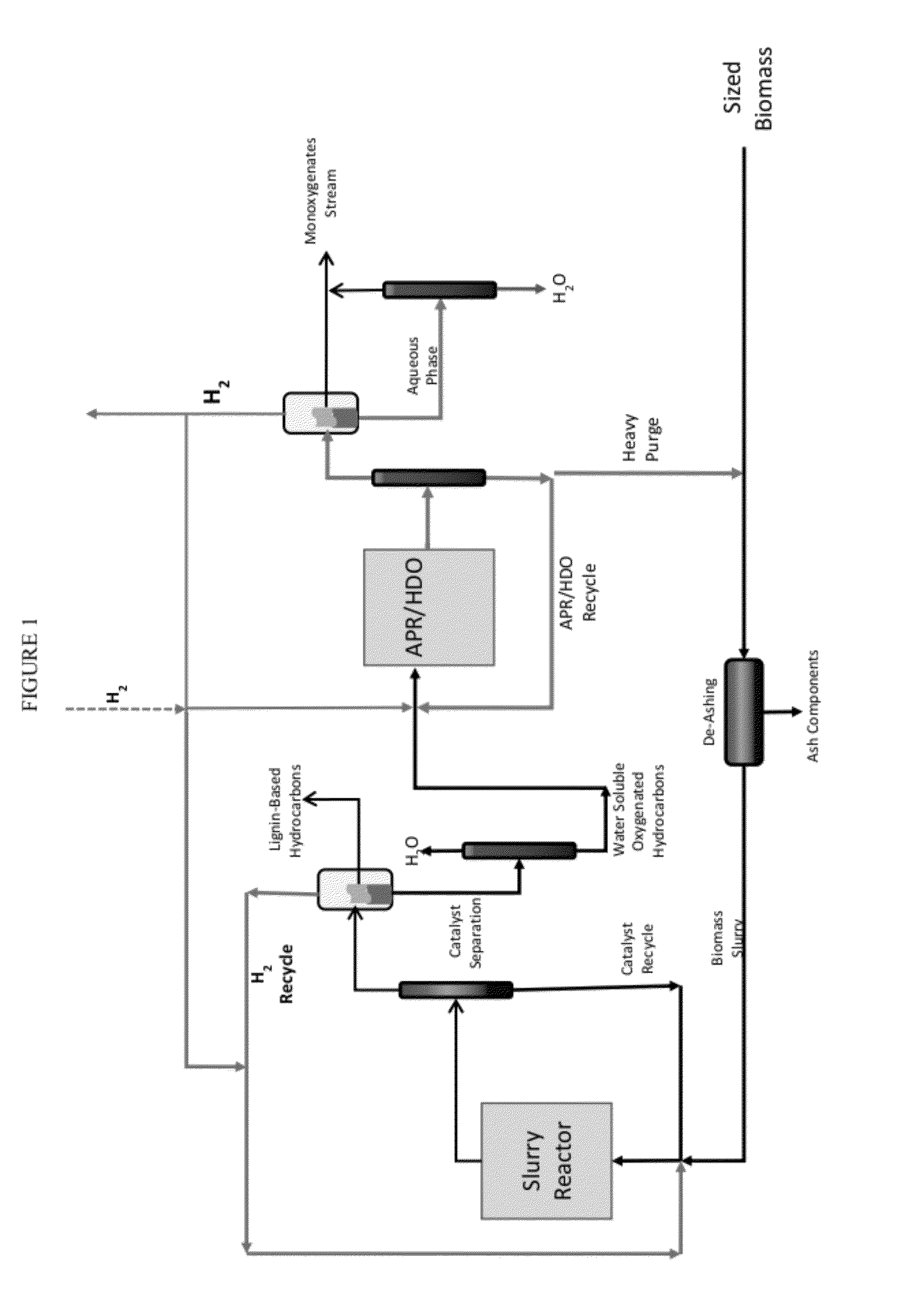Organo-catalytic biomass deconstruction
a biomass deconstruction and organic technology, applied in the field of organic catalytic biomass deconstruction, can solve the problems of no cost-effective process currently available for efficiently converting cellulose, hemicellulose, and lignin
- Summary
- Abstract
- Description
- Claims
- Application Information
AI Technical Summary
Benefits of technology
Problems solved by technology
Method used
Image
Examples
example 1
[0109]Deconstruction of bagasse was conducted using bioreforming organic phase products as a processing solvent, hydrogen and a Ru:Rh / Darco 200 deconstruction catalyst containing 2.5% ruthenium and 2.5% rhodium. The solvent was composed of 70 wt % water miscible bioreforming organic components and 30 wt % water. A biomass slurry having a biomass concentration of 10 wt % sugarcane bagasse in solvent was reacted over a 90 minute heating period and 30 minute retention period at a temperature of 300° C. and 1200 psi H2. A second and third biomass slurry was reacted without the solvent over the same period at 1200 psi H2 and a temperature of 260° C. and 300° C., respectively.
[0110]FIG. 3 shows the experimental results including the yield, aqueous product, and a picture of the reactor following the organo-catalytic deconstruction process. Use of the organic solvent significantly improves biomass deconstruction (from 85% to 95%) and the thick gel that exists in the water medium is solubili...
example 2
[0111]Deconstruction of bagasse and lignin was conducted using bioreforming organic phase products as a processing solvent, hydrogen and various catalysts as depicted in FIG. 4. The solvent was composed of 70 wt % water miscible bioreforming organic components and 30 wt % water. Each biomass slurry had a biomass concentration of 10 wt % biomass (sugarcane bagasse or lignin) in solvent. The biomass slurry was reacted over a 90 minute heating period and 30 minute retention period at a temperature of 300° C. or 260° C. and 1200 psi H2. All catalysts contained metal contents of 2.5 wt % of each metal.
example 3
[0112]Deconstruction of corn stover was conducted using concentrated bioforming aqueous phase reforming products as a solvent, hydrogen and a Pd:Ag / W—ZrO2 deconstruction catalyst containing 2% Pd and Ag. Biomass slurry having a concentration of 10 wt % corn stover in solvent was reacted over a 90 minute heating period at a temperature of 280° C. and 1000 psi H2. The product of this reaction was then reused as the solvent for two subsequent deconstruction trials that followed the same experimental procedures. FIGS. 5 through 8 show the conversion results with both fresh and regenerated catalyst. FIG. 5 indicates that the amount of feedstock converted was the same when using both a fresh and a regenerated catalyst. FIGS. 6-8 show increased product concentrations when a regenerated catalyst was used.
PUM
| Property | Measurement | Unit |
|---|---|---|
| deoxygenation pressure | aaaaa | aaaaa |
| deoxygenation pressure | aaaaa | aaaaa |
| temperature | aaaaa | aaaaa |
Abstract
Description
Claims
Application Information
 Login to View More
Login to View More - R&D
- Intellectual Property
- Life Sciences
- Materials
- Tech Scout
- Unparalleled Data Quality
- Higher Quality Content
- 60% Fewer Hallucinations
Browse by: Latest US Patents, China's latest patents, Technical Efficacy Thesaurus, Application Domain, Technology Topic, Popular Technical Reports.
© 2025 PatSnap. All rights reserved.Legal|Privacy policy|Modern Slavery Act Transparency Statement|Sitemap|About US| Contact US: help@patsnap.com



